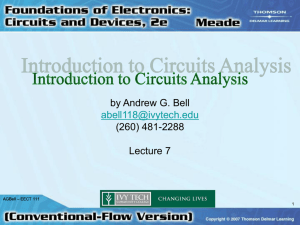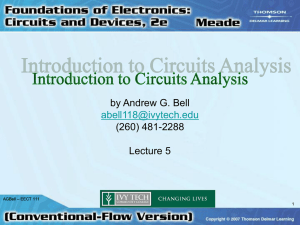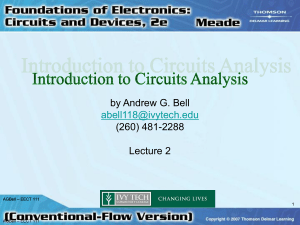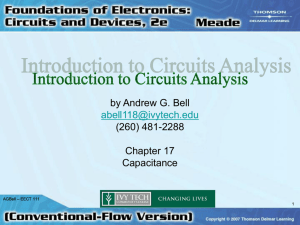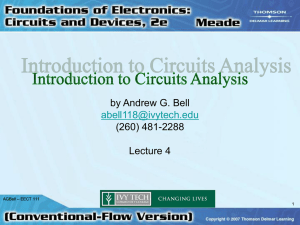Lecture 7 - Ivy Tech Engineering
advertisement
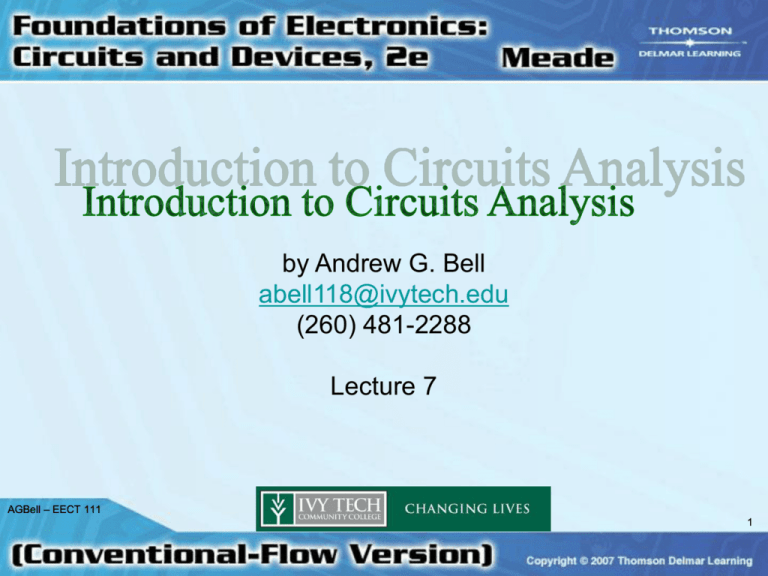
by Andrew G. Bell abell118@ivytech.edu (260) 481-2288 Lecture 7 AGBell – EECT 111 1 CHAPTER 7 Basic Network Theorems AGBell – EECT 111 2 Network Theorem • Network: A complex combination of components • Theorem: Ideas or statements that are used to solve network problems AGBell – EECT 111 3 Network Theorem Assumptions • Linear networks • Steady-state conditions AGBell – EECT 111 4 Network Theorem • Today, computers perform network analysis in seconds. • Technicians need to know the basic concepts of each theorem. AGBell – EECT 111 5 Important Terms • Bilateral Resistance: Resistance having equal resistance in either direction. • Linear Network: A circuit whose electrical behavior does not change with different voltage or current values. • Steady-State Condition: The condition where circuit values and conditions are stable or constant. AGBell – EECT 111 6 Maximum Power Transfer Theorem • Maximum power transferred from the source to the load when RS = RL RS = source resistance RL = load resistance AGBell – EECT 111 7 Series Circuit Example AGBell – EECT 111 8 Efficiency Factor • Measure of the percentage of power generated reaching the source. Pout Efficiency % 100 Pin AGBell – EECT 111 9 Example AGBell – EECT 111 10 Summary of the Maximum Power Transfer Theorem • Maximum power transfer occurs when RS = RL. • Efficiency at maximum transfer is 50%. • When RL is greater than RS, efficiency is larger than 50%. • When RL is less than RS, efficiency is less than 50%. AGBell – EECT 111 11 Power Versus Rl AGBell – EECT 111 12 Efficiency Versus Rl AGBell – EECT 111 13 Superposition Theorem • Used when there are two or more voltage sources in a network. • There are three basic steps to the solution: AGBell – EECT 111 14 Example AGBell – EECT 111 15 Superposition Theorem AGBell – EECT 111 16 Superposition Theorem (cont.) AGBell – EECT 111 17 Summary of Superposition Theorem • Ohm’s law is used to analyze the circuit using one source at a time. • Final results are determined by algebraically superimposing the results of all the sources involved. AGBell – EECT 111 18 Thevenin’s Theorem • A theorem used to simplify complex networks to determine circuit voltages and currents. • States that any linear two-terminal network can be replaced by a simplified equivalent circuit consisting of a single voltage source and a single series resistance. AGBell – EECT 111 19 Thevenin’s Theorem Example AGBell – EECT 111 20 Norton’s Theorem • Is used to reduce a two-terminal network to a single current source and a single parallel resistance. • Any linear two-terminal network can be replaced by an equivalent circuit consisting of a single current source and a single shunt or parallel resistance. AGBell – EECT 111 21 Norton’s Theorem Example AGBell – EECT 111 22 Relationship Between Norton and Thevenin RTH RN VTH I N RN VTH IN RTH AGBell – EECT 111 23
